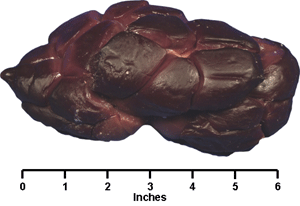Beef Cattle Discovery: Retail Cuts
Beef Cattle Discovery: Retail Cuts
Loin Round Bone Sirloin Steak
Cuts Taken from the Chuck
Rib Steak (Small End)
- Steak taken from the smaller end of the rib, and cut the thickness of one rib (about 1 inch thick).
- Contains a flatter rib bone.
- The oval-shaped ribeye muscle is the major muscle, and it is visible in both faces. Other small muscles also visible.
- Has some fat and connective tissue between muscles in the tapering end (the tail), and thicker outside fat opposite the rib.
*Cookery Method = Dry
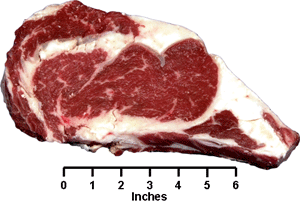
- Roast that is cut more than 2 inches thick (same as the Beef Chuck Arm Roast, except bones have been removed).
- Will have more than 5 distinct muscles.
- Has both intermuscular fat (fat between the muscles) and intramuscular fat (marbling; fat within the muscles).
*Cookery Method = Moist
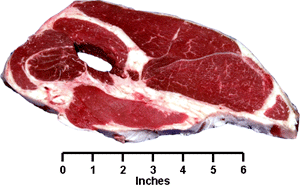
- A steak that is cut less than 2 inches thick (usually about 1/2 inch thick).
- Contains a round arm bone, and may contain cross sections of rib bones.
- Will have more than 5 distinct muscles.
- Has both intermuscular fat (fat between the muscles) and intramuscular fat (marbling; fat within the muscles).
*Cookery Method = Moist
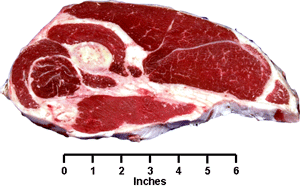
- Steak that is cut less than 2 inches thick, usually about 1/2 inch thick (same as the Beef Chuck arm Steak, except bones have been removed).
- Will have more than 5 distinct muscles.
- Has both intermuscular fat (fat between the muscles) and intramuscular fat (marbling; fat within the muscles).
*Cookery Method = Moist
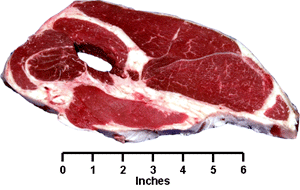
- Roast taken from the center of the blade portion of the Chuck.
- Cut more than 2 inches thick.
- Contains a flaat blade bone in the shape of a "7", backbone, and rib bone.
- Will have more than 5 distinct muscles.
- Has much fat and connective tissue between muscles.
*Cookery Method = Moist
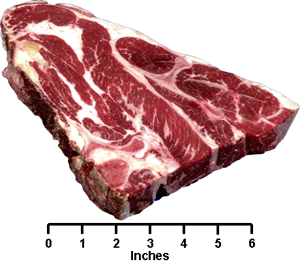
- Steak taken from the center of the blade portion of the Chuck.
- Cut less than 2 inches thick (usually about 1 inch thick).
- Contains a flate blade bone in the shape of a "7", backbone, and rib bone.
- Will have more than 5 distinct muscles.
- Has much fat and connective tissue between muscles.
*Cookery Method = Dry or Moist
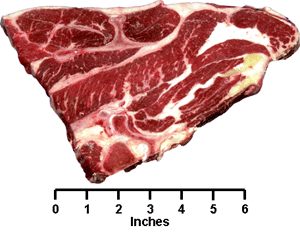
- Roast that is cut more than 2 inches thick.
- Contains a flat blade bone, backbone, and rib bone.
- Will have more than 5 distinct muscles.
- Has much fat and connectivie tissue between muscles.
*Cookery Method = Moist
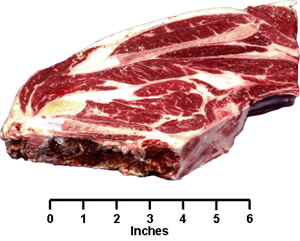
- Steak that is cut less than 2 inches thick, usually about 1 inch thick.
- Contains a flat blade bone, backbone, and rib bone.
- Will have moire than 5 distinct muscles.
- Has much fat and connective tissue between muscles.
*Cookery Method - Dry or Moist
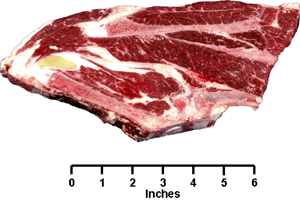
Beef Cattle Discovery Navigation
Cuts Taken from the Loin
- Steak cut less than 2 inches thick (usually about 1 inch thick).
- Contains vertebrae bone (portion of "T" bone) along one side.
- Cut from one primary muscle (top loin muscle).
- Has some fat along the edges.
*Cookery Method = Dry
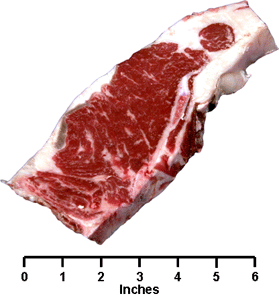
- Steak cut less than 2 inches thick, usually about 1 inch thick (same as Beef Loin top Loin Steak, except bones have been removed).
- Contains no bone.
- Cut from one primary muscle (top loin muscle).
- Has some fat along the edges.
*Cookery Method = Dry
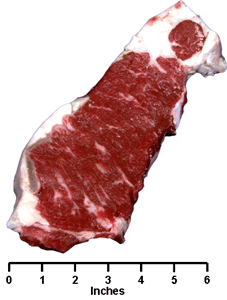
- Steak cut less than 2 inches thick (usually around 1 inch thick).
- Contains vertebrae bone (the "T" bone).
- Contains two primary muscles - the larger muscle is the top loin, the smaller muscle is the tenderloin. Measuered across its center, the tenderloin is between 1/2 and 1 1/4 inches wide.
- Has some fat along the top loin edge.
*Cookery Method = Dry
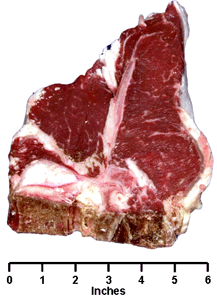
- Steak cut less than 2 inches thick (usually around 1 inch thick).
- Contains vertebrae bone (the "T" bone).
- Contains three primary muscles - the larger muscle is the top loin, the smaller muscle on the opposite side fo the vertebrae is the tenderloin (at least 1 1/4 inches wide, and the jump muscle (small muscle attached ot the outside edge of the top loin muscle).
- Has some fat along the top loin edge.
*Cookery Method = Dry
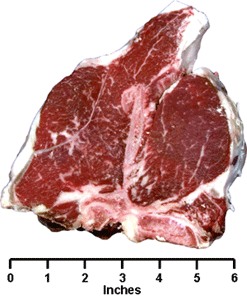
- Steak cut less than 2 inches thick (usually around 1 inch thick).
- Contains backbone and a portion of the hip bone (which can vary in size).
- Contains the top loin and tenderloin muscles. Other small muscles also present.
- Has some fat and connective tissue between muscles, and some fat along the edges.
*Cookery Method = Dry
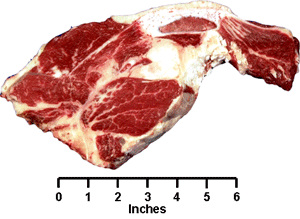
- Steak cut less than 2 inches thick (usually around 1 inch thick).
- Contains hip bone which has a long, flat shape.
- Contains the top loin and tenderloin muscles as the primary muscles. Other small muscles also present.
- Has some fat and connective tissue between muscles, and some fat along the edges.
*Cookery Method = Dry
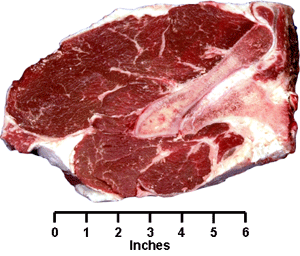
- Steak cut less than 2 inches thick (usually around 1 inch thick).
- Contains hip bone (which resembles a round bone), and a portion of the backbone.
- Largest muscles are the top loin and tenderloin muscles. Other small muscles also present.
- Has some fat and connective tissue between muscles, and some fat along the edges.
*Cookery Method = Dry
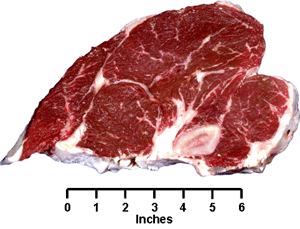
- Steak cut less than 2 inches thick (usually arojnd 1 inch thick).
- Contains hip bone (which is wedge shaped), and a portion of the backbone.
- Muscle structure can vary depending on the location in the sirloin section of loin.
- Has some fat and connective tissue between muscles, and some fat along edges.
*Cookery Method = Dry
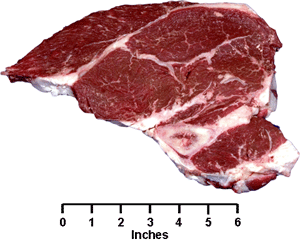
- Steak cut less than 2 inches thick (usually around 1 inch thick).
- Contains hip bone (which is round shaped), and a portion of the backbone.
- Muscle structure similar to other Sirloin Steaks, but tenderloin muscle has been removed.
- Has some fat and connective tissue between muscles, and some fat along the edges.
*Cookery Method = Dry
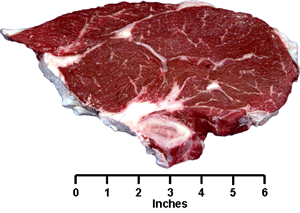
- Steak cut less than 2 inches thick (usually around 1 inch thick).
- Same as the various Beef Loin Sirloin Steaks, but the bones (hip bone and backbone) have been removed.
- Muscle structure varies depending on the location in the sirloin section of loin.
- Has some fat and connective tissue between muscles, and some fat along the edges.
*Cookery Method = Dry
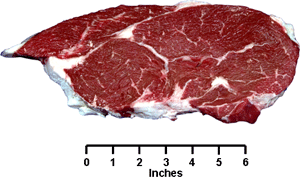
- Steak cut less than 2 inches thick (usually around 1 inch thick) that is taken from the Beef Tenderloin Roast.
- Contains no bones.
- Contains the oval-shaped tenderloin muscles, with a small "spur" on one edge.
- Lean has a very find texture (not grainy).
- Has a small amount of fat over the outside edges.
*Cookery Method = Dry
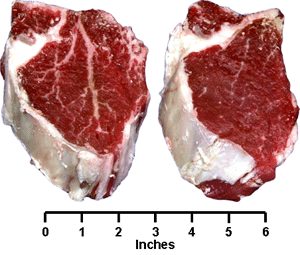
Cuts Taken from the Rib
- Roast taken from the larger end of the rib.
- Cut more than 2 inches thick.
- Contains a flat blade bone on one end and 2-3 curved rib bones on one side.
- Will have more than 5 distinct muscles, but the oval-shaped ribeye muscle will be seen in both faces.
- Has fat and connective tissue between muscles in both the blade and rib faces, and thicker outside fat opposite the ribs.
*Cookery Method = Dry
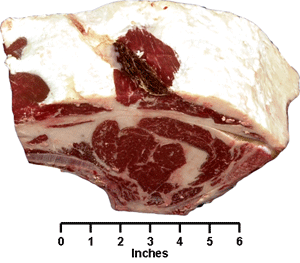
- Roast taken from the smaller end of the rib.
- Cut more than 2 inches thick.
- Contains flatter rib bones on both ends.
- The oval-shaped ribeye muscle is that major muscle, and it is visible in both faces. Other small muscles also visible.
- Has some fat and connective tissue between muscles in the narrower end (the tail), and thicker outside fat opposite the ribs.
*Cookery Method = Dry
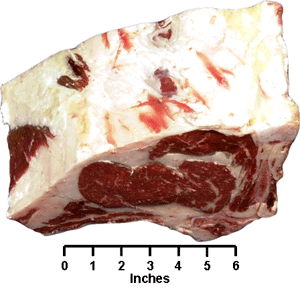
- Steak taken from the smaller end of the rib, and cut the thickness of one rib (about 1 inch thick).
- Contains a flatter rib bone.
- The oval-shaped ribeye muscle is the major muscle, and it is visible in both faces. Other small muscles also visible.
- Has some fat and connective tissue between muscles in the tapering end (the tail), and thicker outside fat opposite the rib.
*Cookery Method = Dry
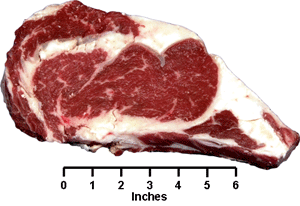
- Steak taken from the smaller end of the rib (same as Beef Rib Steak Small End, except bone has been removed.
- Cut above 1 inch thick.
- The oval-shaped ribeye muscle is the major muscle, and it is visible in both faces. Other small muscles also visible.
- Has some fat and connective tissue between muscles in the tapering end (the tail).
*Cookery Method = Dry
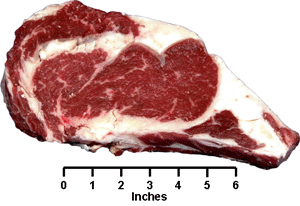
- Boneless roast taken from the rib.
- Cut more than 2 inches thick.
- The major muscle is the oval-shaped ribeye muscle and it is visible in both faces. Other small muscles also visible on one side.
- Has some fat and connective tissue between muscles.
*Cookery Method = Dry
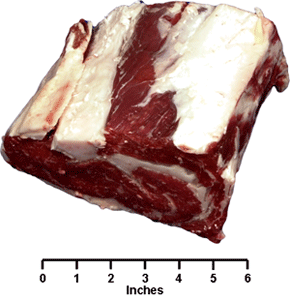
- Boneless steak cut across the grain grom the Beef Ribeye Roast.
- Cut less than 2 inches thick (usually about 1 inch thick).
- The major muscle is the oval-shaped ribeye muscle and it is visible in both faces. Other small muscles also visible.
- Has some fat and connective tissue between muscles, but has little or no outside fat.
*Cookery Method = Dry
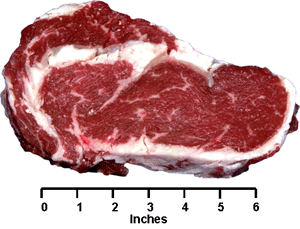
Cuts Taken from the Brisket
- Cut taken from the breast section, between the fore shank and the plate.
- Contains no bones.
- Large, grainy cut of meat made of several layers of coarse, fatty muscles with a diagonal grain.
*Cookery Method = Moist
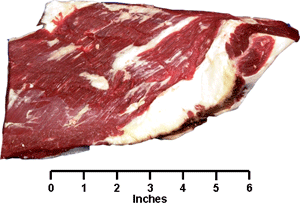
- Cut taken from the rear portion of the Beef Whole Brisket (sides are cut nearly parallel).
- Contains no bones.
- Large, grainy cut of meat made of several layers of coarse, fatty muscles with a diagonal grain.
*Cookery Method = Moist
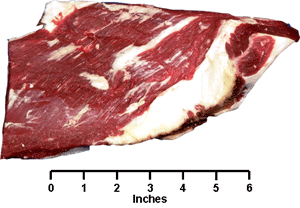
- Cut taken from the forward portion of the Beef Whole Brisket (cut so that it tapers to a point).
- Contains no bones.
- Grainy cut of meat made of several layers of coarse, fatty muscles with a diagonal grain.
*Cookery Method = Moist
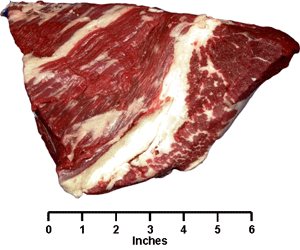
Cuts Taken from the Shank
- Tough cuts taken from either the foreshank or hindshank.
- Cut perpendicular to the bone, usually 1 to 2 1/2 iches thick.
- Contains one round leg bone.
- Wil have several muscles from the "forearm" surrounding the round bone.
- Has connective tissue seperating the muscles.
*Cookery Method = Moist
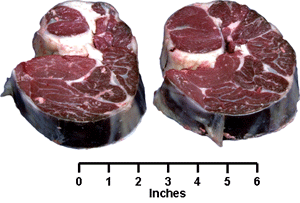
- Tough cuts taken from either the foreshank or hindshank, and usually cut 1 to 2 1/2 inches thick (same as Beef Shank Cross Cuts, except round leg bone has been removed).
- Will have several muscles from the "forearm".
- Has connective tissue separating the muscles.
*Cookery Method = Moist
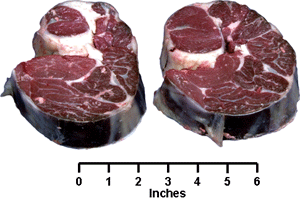
Cuts Taken from the Round
- Steak cut less than 2 inches thick (usually around 1 inch thick).
- Contains one round bone.
- Oval-shaped cut with three distinct muscles - top round, bottom round, and eye of round.
- Has a small amount of fat over the outside edges, and fat and connective tissue between muscles.
*Cookery Method = Moist
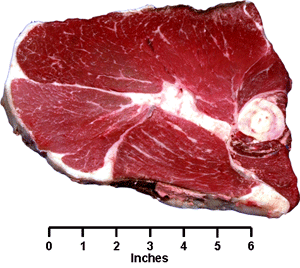
- Steak cut less than 2 inches thick, usually around 1 inch thick (same as Beef Round Steak, except bone has been removed).
- Contains no bone.
- Oval-shaped cut with three distinct muscles - top round, bottom round, and eye of round.
- Has a small amount of fat over the outside edges, and fat and connective tissue between muscles.
*Cookery Method = Moist
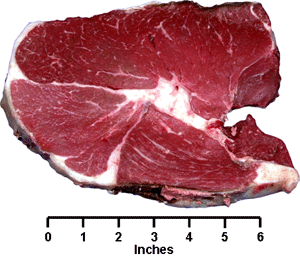
- Roast cut more than 2 inches thick (same as Beef Round Rump Roast, except bones have been removed).
- Contains no bone.
- Contains three muscles - top round, bottom round, and eye of round. Usually tied together.
- Has a small amount of fat over the outside edges, and fat and connective tissue between muscles.
*Cookery Method = Dry or Moist
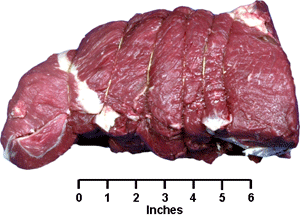
- Roast cut more than 2 inches thick.
- Contains no bone.
- Contains the top (inside) muscle of the round.
- Has some fat over the outside.
*Cookery Method = Dry
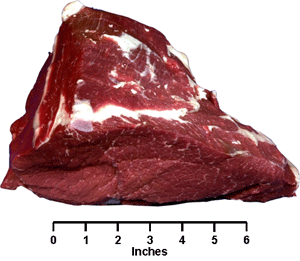
- Steak cut less than 2 inches thick (usually 2 inch or less thick).
- Contains no bone.
- Contains one large oval-shaped muscle (top muscle of the round) made from half of a round steak.
- Has some fat over the outside.
*Cookery Method = Dry
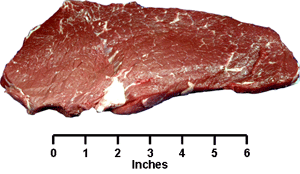
- Irregular-shaped roast cut more than 2 inches thick.
- Contains no bone.
- Contains two muscles - one large muscle (bottom or outside section of the Round) which is wider at the bottom than the top, and one smaller muscle on one side.
- Has some outside fat on the bottom edge, and a small amount of fat or connective tissue seperating the two muscles.
*Cookery Method = Dry or Moist
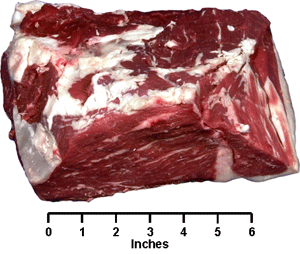
- Steak cut less than 2 inches thick (usually thin steaks about 1/2 inch thick).
- Contains no bone.
- Contains two muscles - one large muscle (bottom or outside section of the Round), and one smaller muscle on one side.
- Has some outside fat on the bottom edge, and a small amount of fat or connective tissue seperating the two muscles.
*Cookery Method = Moist
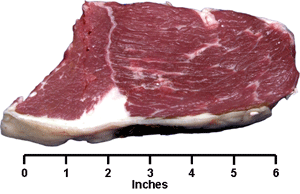
- Roast cut more than 2 inches thick.
- Contains no bone.
- Contains one oval-shaped muscle (eye round muscle) which has been seperated from the bottom round muscle.
- Muscle has a coarse, grainy texture.
- Has a thin layer of fat on the outside edges.
*Cookery Method = Dry or Moist
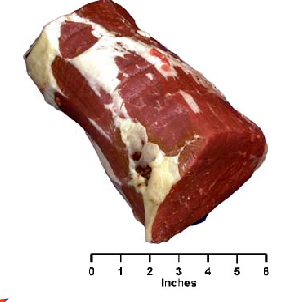
- Steak cut less than 2 inches thick (usually about 1 inch thick) that is taken from the Beef Round Eye Round Roast.
- Contains no bone.
- Contains one oval-shaped muscle (eye round muscle) which has a coarse, grainy texture.
- Has a thin layer of fat on the outside edges.
*Cookery Method = Dry or Moist
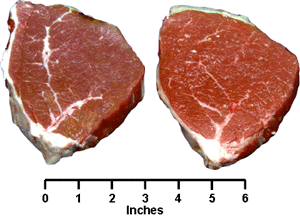
- Large, thick, wedge-shaped roast cut from the thin side of the Round.
- Contains no bone.
- Contains one large muscle divided into thirds by connective tissue, with a crescent shaped cap muscle of the sirloin on top.
- Has a layer of fat on the outside edges.
*Cookery Method = Dry or Moist
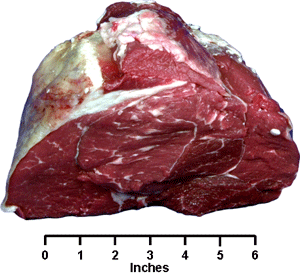
- Wedge-shaped steak cut less than 2 inches thick (usually about 1 inch thick) from the Beef Round Tip Roast.
- Contains no bone.
- Contains one large muscle divided into thirds by connective tissue, with a crescent-shaped cap muscle of the sirloin on top.
- Has a layer of fat on the outside edges.
*Cookery Method = Dry
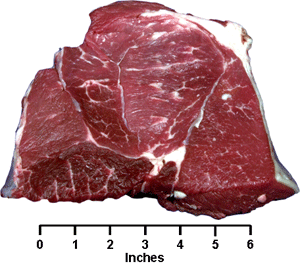
- Large, thick roast cut from the thin side of the Round.
- Similar to the Beef Rount Tip Roast, but the cap muscle has been removed from the top.
- Contains no bone.
- Contains one large muscle divided into thirds by connective tissue.
- Has a layer of fat on the outside edges.
*Cookery Method = Dry or Moist
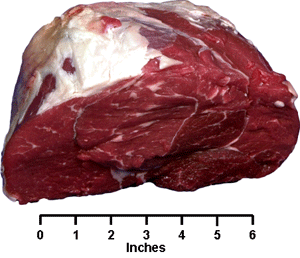
- Large steak cut less than 2 inches thick (usually less than 1 inch thick) from the Beef Round Tip Roast Cap Off.
- Contains no bone.
- Contains one large muscle divided into thirds by connective tissue (crescent-shaped cap muscle of the sirloin has been removed from the top).
- Has a layer of fat on the outside edges.
*Cookery Method = Dry
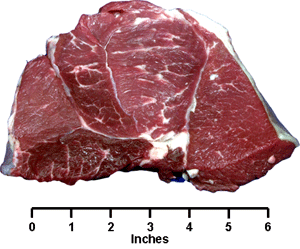
- Thick, wedge-shaped roast cut from the lower Round (leg) section.
- Similar to the Beef Round Tip Roast, but the cap muscle has been removed from the top.
- Contains no bone.
- Contains several muscles of the Round.
- Has a layer of fat on the outside edges and contains a substantial amount of connective tissue between muscles.
*Cookery Method = Moist
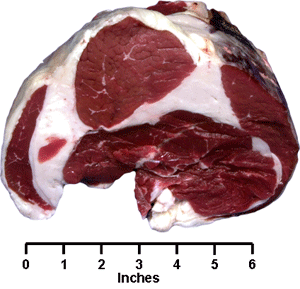
Cuts Taken from the Plate
- Long, thin, steak made from the diaphragm muscle.
- Contains no bones.
- Has considerable amounts of outside fat.
- Often rolled up and held in place by skewers for cooking.
*Cookery Method - Dry or Moist
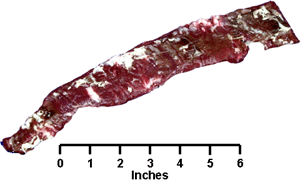
- Rectangular-shaped cuts from the plat.
- Contains lower end of rib bones.
- Has alternating layers of lean and fat.
*Cookery Method = Moist
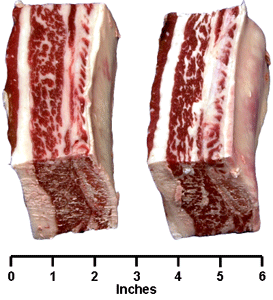
Cuts Taken from the Flank
- Flat, oval-shaped steak taken from the Flank.
- Contains no bones.
- Contains elongated muscle fibers with the grain running length-wise along the cut.
- Very lean cut (has little fat).
*Cookery Method = Dry or Moist
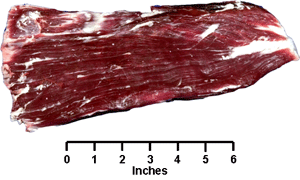
Beef Variety Meat Cuts
- Irregular cube-shaped pieces of lean (usually cut into 1 to 1 1/2 inch cubes) taken from several different parts of the carcass.
- Contains no bone.
- Contains varying amounts of fat.
*Cookery Method = Moist
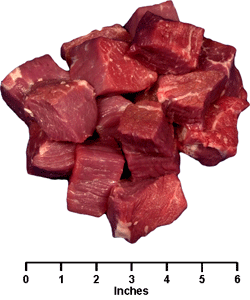
- Larger in size than kidney from lamb or pork.
- Consists of several lobes.
*Cookery Method = Dry or Moist
